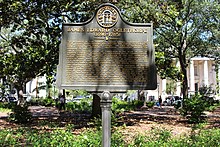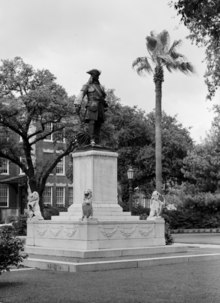
Savannah is the oldest city in the U.S. state of Georgia and the county seat of Chatham County. Established in 1733 on the Savannah River, the city of Savannah became the British colonial capital of the Province of Georgia and later the first state capital of Georgia. A strategic port city in the American Revolution and during the American Civil War, Savannah is today an industrial center and an important Atlantic seaport. It is Georgia's fifth most populous city, with a 2020 U.S. census population of 147,780. The Savannah metropolitan area, Georgia's third-largest, had a 2020 population of 404,798.

Daniel Chester French was an American sculptor of the late nineteenth and early twentieth centuries. He is best known for his 1874 sculpture The Minute Man in Concord, Massachusetts, and his 1920 monumental statue of Abraham Lincoln in the Lincoln Memorial in Washington, D.C.

Tomochichi (to-mo-chi-chi') was the head chief of a Yamacraw town on the site of present-day Savannah, Georgia, in the 18th century. He gave land on Yamacraw Bluff to James Oglethorpe to build the city of Savannah. He remains a prominent historical figure of early Georgia history. As the principal mediator between the native population and the new British settlers during the first years of settlement, he contributed much to the establishment of peaceful relations between the two groups and to the ultimate success of Georgia.
The city of Savannah, Province of Georgia, was laid out in 1733, in what was colonial America, around four open squares, each surrounded by four residential "tithing") blocks and four civic ("trust") blocks. The layout of a square and eight surrounding blocks was known as a "ward." The original plan was part of a larger regional plan that included gardens, farms, and "outlying villages." Once the four wards were developed in the mid-1730s, two additional wards were laid. Oglethorpe's agrarian balance was abandoned after the Georgia Trustee period. Additional squares were added during the late 18th and 19th centuries, and by 1851 there were 24 squares in the city. In the 20th century, three of the squares were demolished or altered beyond recognition, leaving 21. In 2010, one of the three "lost" squares, Ellis, was reclaimed, bringing the total to today's 22.
The city of Savannah, Georgia, the largest city and the county seat of Chatham County, Georgia, was established in 1733, and was the first colonial and state capital of Georgia. It is known as Georgia's first planned city and attracts millions of visitors, who enjoy the city's architecture and historic structures such as the birthplace of Juliette Gordon Low, the Telfair Academy of Arts and Sciences, the First African Baptist Church, Congregation Mickve Israel, and the Central of Georgia Railway roundhouse complex. Today, Savannah's downtown area is one of the largest National Historic Landmark Districts in the United States .[A]

The Oglethorpe Plan is an urban planning idea that was most notably used in Savannah, Georgia, one of the Thirteen Colonies, in the 18th century. The plan uses a distinctive street network with repeating squares of residential blocks, commercial blocks, and small green parks to create integrated, walkable neighborhoods.

James Edward Oglethorpe was a British soldier, Member of Parliament, and philanthropist, and the founder of the Province of Georgia in what was then colonial-era British America. As a social reformer, he hoped to resettle Britain's "worthy poor" in the New World, initially focusing on those in debtors' prisons.
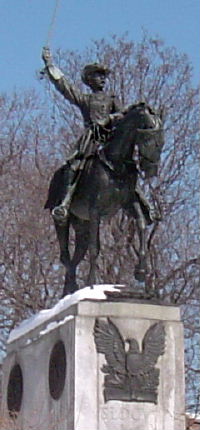
The equestrian statue of Henry Warner Slocum is a monumental statue in Brooklyn's Grand Army Plaza, in New York City. The equestrian statue, designed by sculptor Frederick William MacMonnies, was dedicated in 1905 in honor of Henry Warner Slocum, who served as a general in the Union Army during the American Civil War and later as a U.S. Representative from the state of New York.

The Civil War Memorial in Savannah, Georgia, is a monument honoring soldiers who died during the American Civil War. Located in Forsyth Park, it consists of a 48 foot (15 m) tall shaft topped with a bronze statue of a Confederate soldier. Two bronze busts commemorating notable Confederate army officers flank the monument, which is protected by a railing, one of the only two that still stand around a monument, the other being the Casimir Pulaski Monument in Monterey Square. Originally known as the Confederate Monument, it was dedicated in 1875 to honor Confederate soldiers who died during the Civil War. Following the Unite the Right rally, the city of Savannah renamed and rededicated the structure in 2018. The monument is one of the oldest and largest Confederate monuments in Georgia.
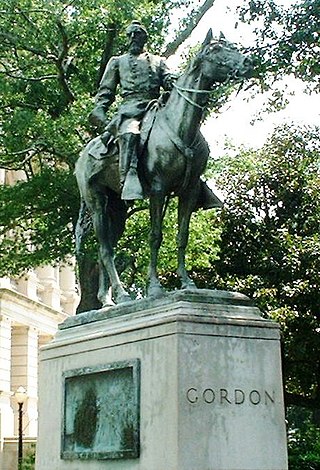
The equestrian statue of John Brown Gordon is a monument on the grounds of the Georgia State Capitol in Atlanta, Georgia, United States. The monument, an equestrian statue, honors John Brown Gordon, a general in the Confederate States Army during the American Civil War who later become a politician in post-Reconstruction era Georgia. Designed by Solon Borglum, the statue was dedicated in 1907 to large fanfare. The statue has recently become a figure of controversy over Gordon's racist views and associations with the Confederacy, with some calling for its removal.

The William Jasper Monument is a monument honoring William Jasper in Savannah, Georgia, United States. Located in Madison Square, the monument was designed by Alexander Doyle and dedicated in 1888.

The William Washington Gordon Monument is a public monument in Savannah, Georgia, United States. Located in Wright Square, the monument honors politician and businessman William Washington Gordon and was designed by Henry Van Brunt and Frank M. Howe. It was completed in 1883.

The Nathanael Greene Monument is a public monument in Savannah, Georgia, United States. Located in Johnson Square, the monument was designed by William Strickland and honors Nathanael Greene, a general in the Continental Army during the American Revolutionary War. While the cornerstone was laid in 1825, the monument was not completed until 1830, at which time it served as a joint monument for Greene and fellow Continental Army general Casimir Pulaski. The monument became solely dedicated to Greene in 1853, after which two bronze plaques honoring Greene were added to the structure. In 1902, Greene's body was reinterred under the monument. In 2018, one of the bronze plaques was vandalized with googly eyes, which drew national attention to the monument.

The Stewart–Screven Monument is a monument in Midway, Georgia, United States. Erected in 1915, the monument honors Daniel Stewart and James Screven, two generals from the American Revolutionary War. The monument is located in a cemetery in the Midway Historic District.
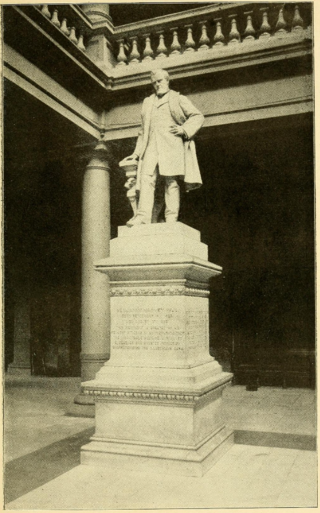
A statue of Benjamin Harvey Hill stands inside the Georgia State Capitol in Atlanta, Georgia, United States. The monumental statue was designed by American sculptor Alexander Doyle and originally dedicated in 1886 at what is now Hardy Ivy Park. The statue was relocated to the capitol building in 1890.

Reynolds Square is one of the 22 squares of Savannah, Georgia, United States. It is located in the northernmost row of the city's five rows of squares, on Abercorn Street and East St. Julian Street. It is east of Johnson Square, west of Warren Square and north of Oglethorpe Square. The oldest building on the square is The Olde Pink House, which dates to 1771.

Oglethorpe Square is one of the 22 squares of Savannah, Georgia, United States. It is located in the second row of the city's five rows of squares, on Abercorn Street and East President Street, and was laid out in 1742. It is south of Reynolds Square, west of Columbia Square, north of Colonial Park Cemetery and east of Wright Square. The oldest building on the square is the Owens–Thomas House, at 124 Abercorn Street, which dates 1819.

Chippewa Square is one of the 22 squares of Savannah, Georgia, United States. It is located in the middle row of the city's five rows of squares, on Bull Street and McDonough Street, and was laid out in 1815. It is south of Wright Square, west of Colonial Park Cemetery, north of Madison Square and east of Orleans Square. The oldest building on the square is The Savannah Theatre, at 222 Bull Street, which dates to 1818.

Madison Square is one of the 22 squares of Savannah, Georgia, United States. It is located in the fourth row of the city's five rows of squares, on Bull Street and Macon Street, and was laid out in 1837. It is south of Chippewa Square, west of Lafayette Square, north of Monterey Square and east of Pulaski Square. The square is named for James Madison, fourth president of the United States. The oldest building on the square is the Sorrel–Weed House, at 6 West Harris Street, which dates to 1840.
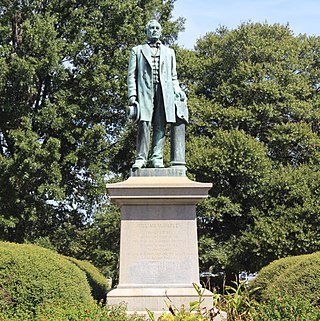
William M. Wadley is a public monument in Macon, Georgia, United States. The monument, which consists of a bronze statue atop a granite pedestal, was designed by Robert Cushing and dedicated in 1885 in honor of William Morrill Wadley, a railroad executive for the Central of Georgia Railroad who had died several years earlier. The monument was erected by a committee made up of his former employees and stands near the city's Terminal Station.



